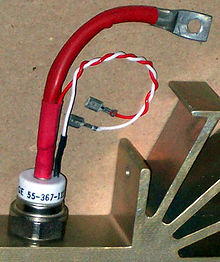
Back Tiristor Afrikaans ثايرستور Arabic Tiristor AST Tiristor Azerbaijani Тырыстар Byelorussian Тырыстар BE-X-OLD Тиристор Bulgarian থাইরিস্টর Bengali/Bangla Tiristor BS Tiristor Catalan
 Thyristor | |
| Type | Active |
|---|---|
| First production | 1956 |
| Pin configuration | anode, gate and cathode |
| Electronic symbol | |
 | |
A thyristor (/θaɪˈrɪstər/) is a solid-state semiconductor device which can be thought of as being a highly robust and switchable diode, allowing the passage of current in one direction but not the other, often under control of a gate electrode, that is used in high power applications like inverters and radar generators. It usually consists of four layers of alternating P- and N-type materials.[1]: 12 It acts as a bistable switch (or a latch).[1]: 12 There are two designs, differing in what triggers the conducting state. In a three-lead thyristor, a small current on its gate lead controls the larger current of the anode-to-cathode path. In a two-lead thyristor, conduction begins when the potential difference between the anode and cathode themselves is sufficiently large (breakdown voltage). The thyristor continues conducting until the voltage across the device is reverse-biased or the voltage is removed (by some other means),[1]: 12 or through the control gate signal on newer types.
Some sources define "silicon-controlled rectifier" (SCR) and "thyristor" as synonymous.[2] Other sources define thyristors as more complex devices that incorporate at least four layers of alternating N-type and P-type substrate.
The first thyristor devices were released commercially in 1956. Because thyristors can control a relatively large amount of power and voltage with a small device, they find wide application in control of electric power, ranging from light dimmers and electric motor speed control to high-voltage direct-current power transmission. Thyristors may be used in power-switching circuits, relay-replacement circuits, inverter circuits, oscillator circuits, level-detector circuits, chopper circuits, light-dimming circuits, low-cost timer circuits, logic circuits, speed-control circuits, phase-control circuits, etc. Originally, thyristors relied only on current reversal to turn them off, making them difficult to apply for direct current; newer device types can be turned on and off through the control gate signal. The latter is known as a gate turn-off thyristor, or GTO thyristor.
Unlike transistors, thyristors have a two-valued switching characteristic, meaning that a thyristor can only be fully on or off, while a transistor can lie in between on and off states. This makes a thyristor unsuitable as an analog amplifier, but useful as a switch.
- ^ a b c Paul, P. J. (2003). Electronic devices and circuits. New Delhi: New Age International. ISBN 81-224-1415-X. OCLC 232176984.
- ^ Christiansen, Donald; Alexander, Charles K. (2005); Standard Handbook of Electrical Engineering (5th ed.). McGraw-Hill, ISBN 0-07-138421-9
© MMXXIII Rich X Search. We shall prevail. All rights reserved. Rich X Search